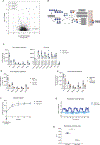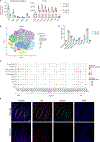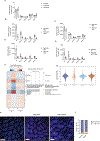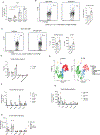γδ T cells regulate the intestinal response to nutrient sensing
- PMID: 33737460
- PMCID: PMC11617329
- DOI: 10.1126/science.aba8310
γδ T cells regulate the intestinal response to nutrient sensing
Abstract
The intestine is a site of direct encounter with the external environment and must consequently balance barrier defense with nutrient uptake. To investigate how nutrient uptake is regulated in the small intestine, we tested the effect of diets with different macronutrient compositions on epithelial gene expression. We found that enzymes and transporters required for carbohydrate digestion and absorption were regulated by carbohydrate availability. The "on-demand" induction of this machinery required γδ T cells, which regulated this program through the suppression of interleukin-22 production by type 3 innate lymphoid cells. Nutrient availability altered the tissue localization and transcriptome of γδ T cells. Additionally, transcriptional responses to diet involved cellular remodeling of the epithelial compartment. Thus, this work identifies a role for γδ T cells in nutrient sensing.
Copyright © 2021 The Authors, some rights reserved; exclusive licensee American Association for the Advancement of Science. No claim to original U.S. Government Works.
Conflict of interest statement
Figures




Comment in
-
Immune cell control of nutrient absorption.Science. 2021 Mar 19;371(6535):1202-1203. doi: 10.1126/science.abg6455. Science. 2021. PMID: 33737473 No abstract available.
References
-
- Karasov WH, Martinez del Rio C, Caviedes-Vidal E, Ecological physiology of diet and digestive systems. Annu Rev Physiol 73, 69–93 (2011). - PubMed
-
- Furness JB, The enteric nervous system and neurogastroenterology. Nat Rev Gastroenterol Hepatol 9, 286–294 (2012). - PubMed
-
- Hoytema van Konijnenburg DP, Mucida D, Intraepithelial lymphocytes. Curr Biol 27, R737–R739 (2017). - PubMed
-
- Gribble FM, Reimann F, Function and mechanisms of enteroendocrine cells and gut hormones in metabolism. Nature Reviews Endocrinology 15, 226–237 (2019). - PubMed
Publication types
MeSH terms
Substances
Grants and funding
LinkOut - more resources
Full Text Sources
Other Literature Sources
Medical
Molecular Biology Databases

